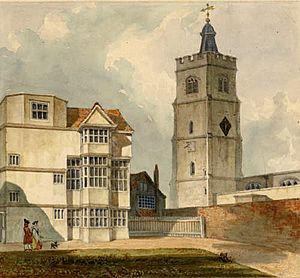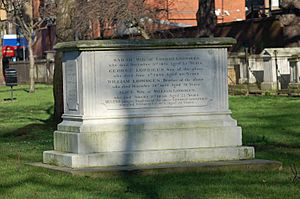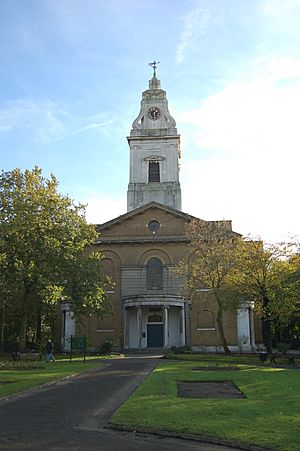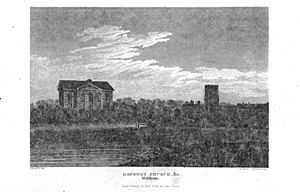Church of St John-at-Hackney facts for kids
Quick facts for kids St John at Hackney Church |
|
|---|---|
| Hackney Church | |
| Location | London Borough of Hackney |
| Country | England |
| Denomination | Church of England |
| Churchmanship | Anglican |
| Website | https://saint.church |
| History | |
| Founded | 1275 |
| Dedicated | 15 July 1797 |
| Architecture | |
| Architect(s) | James Spiller |
| Years built | 1792 |
| Administration | |
| Parish | The Parish of Hackney |
| Diocese | Diocese of London |
St John at Hackney is a large Anglican church in the heart of London Borough of Hackney. It can hold about 2,000 people. The church was built in 1792. It replaced Hackney's older medieval church. Only St Augustine's Tower from the old church still stands. The church is also a popular music venue. Famous artists like Coldplay, Ed Sheeran, and Robbie Williams have performed there.
Contents
History of Hackney Church
The church of St John at Hackney was designed by James Spiller. It was built in 1792 because the local population had grown a lot. The old church was too small for over 3,000 people. This large, classical-style building can hold around 2,000 people. It is a Grade II* listed building. This means it is a very important historical building. Inside, you can find old monuments from the early 1500s. These were moved from the older medieval church.
The First Church: St Augustine's
There might have been a small chapel here even before the Norman Conquest in 1066. Records show a chapel existed by 1275. It was part of the larger Stepney parish. For a long time, the church was named after Saint Augustine of Hippo. But in 1660, it was renamed. It became known as St John the Baptist, or St John at Hackney.
In the 1200s, much of the land in Hackney belonged to the Knights Templar. When their group was ended, their lands went to the Order of St. John of Jerusalem. This group had a large house on Church Street. Later, during the Dissolution of the Monasteries, the lands became owned by the Crown. They were then given to important people like Thomas Sutton.

A Growing Community Needs a Bigger Church
Hackney was close to the City of London and the royal court. This made it a popular place for important people to live. More private schools also opened in older houses. By 1789, the church could hold 1,000 people. But this was still not enough for the growing population.
In 1779, a surveyor suggested rebuilding the church. This would make it hold 1,480 people. But nothing happened. By 1788, a committee found that the population had grown so much. They decided the church needed to seat 3,000 people. The chosen architect, William Blackburn, said a new church should be built. He suggested buying new land for it.
In 1789, the community voted on the idea. Most people agreed to build a new church. They decided to buy land called Church Field. This land was to the north-east of the old churchyard.
Building the New Church
The plan was to build a new church, tower, and vestry room. The old church would then be taken down. Only its tower would remain. The first cost estimates were too low. More money had to be raised later.
William Blackburn, the first architect, died in 1790. A month later, James Spiller was chosen. Hackney Church became his biggest and most important project. He believed a church for 3,000 people would sound bad. So, he convinced the church to build for 2,000 people instead. He still thought the sound would only be good if the church was full.
Construction started in 1792. The main building took over two years to finish. The church was officially opened on July 15, 1797.

Harry Sedgwick, a church trustee, helped plant trees in the churchyard. Many elm and horse chestnut trees were planted. Sedgwick was later buried there. His tomb remembers his planting efforts.
In March 1798, the old church building was taken down. Some tombs were moved to the new church. The old tower stayed to hold the bells. There wasn't enough money to build a new tower on the new church yet. In 1814, a tower was added to the new church. In 1816, a beautiful stained glass window was put behind the altar.
The old tower of St Augustine's Church is still standing. It is an important symbol for Hackney. It has been on the front page of the Hackney Gazette newspaper since 1864. It is also on the coat of arms of the London Borough of Hackney. In 1871, a clock was added to the tower. It started working on New Year's Day in 1872.
In 1890, the church bought an old house from the early 1500s. A school was built in its grounds. The house became the St John's Church Institute. Later, the National Trust bought it. It is now known as Sutton House.
The churchyard stopped being used for burials in 1859. It became overgrown. In 1894, it was cleaned up and opened as a public park.
In 1902, the church was repaired. Electric lights were installed. In the 1920s, the roof became unsafe. The church had to close for a while. The roof was rebuilt in 1929.
A stone monument in the churchyard remembers the people from Hackney who died in wars. It was put up in 1921.
Fire and Rebuilding

The roof repairs from the 1920s didn't completely fix the problems. More work was planned for 1954. On May 18, 1955, a fire started in the church roof. It destroyed the roof, some seats, and the old organ. During the rebuilding, some changes were made inside. A new hall, called Hurdman Hall, was created.
A new organ was brought from another church. Altar hangings made for the coronation of Queen Elizabeth II were donated. A new stained glass window was designed by Christopher Webb. The new church was officially opened again on June 24, 1958.
In 2008, the church and its churchyard were rededicated. This celebrated 50 years since the rebuilding. It also marked the improvements made to the church gardens. St John's Church Gardens have won awards for being beautiful public spaces. As of 2022, the churchyard still holds a Green Flag award.
The church building still needed a lot of care. A big Restoration project started in 2018. This project aimed to bring the church back to its original design. It also created more space for church services and music events. New features include two new chapels and a raised stage.
How the Church Works Today
Church Leaders
The main leader of Hackney Church is Rev'd Al Gordon. He started in 2016. Other leaders include Rev'd Mark Nelson and Rev'd Naomi Maxwell.
Restoration Project Details
In 2018, St John at Hackney began a huge Restoration project. It received a large grant of £1.84 million from the National Lottery Heritage Fund. Famous designers like John Pawson and Es Devlin worked on the project. In 2019, the church opened new community spaces. These help the church do more outreach work. The church reopened for services and events in September 2020. Since then, many thousands of people have visited.
The church's restoration won a national award in 2022.
Notable People Buried Here
Many interesting people are buried at St John at Hackney. Here are a few:
- Francis Beaufort: He created the Beaufort scale, which measures wind speed.
- Edward de Vere, 17th Earl of Oxford: An Elizabethan courtier, poet, and playwright.
- Timothy Hall: A former Bishop of Oxford.
- Joachim Conrad Loddiges: A famous botanist who studied plants.
- William Nash: He received the Victoria Cross, a very brave award.
- Henry Percy, 6th Earl of Northumberland: A nobleman who was once thought to be engaged to Anne Boleyn.
- Sir Henry Rowe: A former Mayor of London.
- Christopher Urswick: A former leader of Hackney Church and Dean of Windsor.



